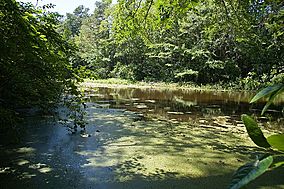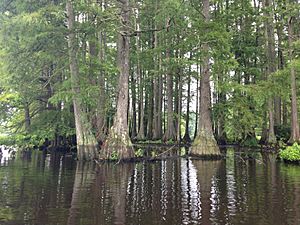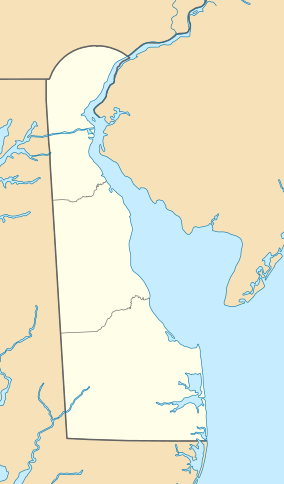Trap Pond State Park facts for kids
Quick facts for kids Trap Pond State Park |
|
|---|---|
 |
|
| Location | Sussex County, Delaware, United States |
| Area | 3,653 acres (14.78 km2) |
| Elevation | 39 ft (12 m) |
| Established | 1951 |
| Named for | Trap Pond |
| Governing body | Delaware Department of Natural Resources and Environmental Control |
| Website | Trap Pond State Park |
Trap Pond State Park is a beautiful state park in Delaware, USA. It covers about 3,653 acres, which is like 2,700 football fields! You can find it near Laurel, Delaware, in Sussex County.
This park is special because it protects a large part of what used to be a huge wetland. Wetlands are areas where the land is covered by shallow water. Trap Pond is also famous for its amazing bald cypress trees. These unique trees grow right out of the water!
| Top - 0-9 A B C D E F G H I J K L M N O P Q R S T U V W X Y Z |
Discovering Bald Cypress Trees and Wildlife

The bald cypress is a special tree that loves to grow in wetlands. It needs calm, shallow water to thrive. Trap Pond State Park is the most northern place in North America where you can see many of these cypress trees. You can find them a bit further north in Delaware, but Trap Pond has a large, beautiful collection.
Birds and Other Animals at Trap Pond
Many different birds love to live among the bald cypress trees. You might spot large great blue herons, wise owls, and colorful warblers. Look for the big pileated woodpeckers too! If you visit at the right time of year, you could even see tiny hummingbirds or majestic bald eagles soaring above.
You can also find large American holly trees in the park. The American holly is the state tree of Delaware.
The History of Trap Pond State Park
The wood from the bald cypress trees at Trap Pond is very strong and doesn't rot easily. Because of this, people started cutting down these trees a lot in the 1700s. To help cut the wood, lumberjacks built a dam. This dam blocked the water flow and created what we now call Trap Pond. The pond was named after the "Trap Mills," which were sawmills known by that name around the 1860s.
Later, farmers nearby made the pond even bigger. They added drainage tiles to remove water from their fields for farming. After most of the old cypress trees were cut, the pond became a place to collect water from the surrounding farms.
Becoming Delaware's First State Park
In the 1930s, a group called the Civilian Conservation Corps saw Trap Pond as a great place for fun activities. The Delaware legislature agreed and officially made it a state park on June 22, 1951. This made Trap Pond State Park the very first state park in Delaware!
Fun Things to Do at Trap Pond
Trap Pond is a wonderful place for families to have fun outdoors. The pond covers about 90 acres, which is a lot of space for activities!
Boating Adventures
You can rent different kinds of boats at the park. They have canoes, kayaks, rowboats, and pedal boats. If you have your own small boat, there's a ramp to launch it.
Fishing Fun
Fishing is popular at Trap Pond. You can try to catch fish like crappie and bluegill. Sometimes, you might even reel in a bass or an pickerel!
Bald Cypress Nature Center
The Bald Cypress Nature Center is a great place to learn more about the park. It has displays of reptiles, fish, and amphibians that live in Trap Pond. You can also see other natural history exhibits and find books about nature. The center is open every day during spring and summer. They offer fun programs like hayrides, guided nature walks, and boat tours on a pontoon boat. You can also learn outdoor skills!
Camping Under the Stars
Trap Pond State Park has a large campground with 142 campsites. Most sites have water and electricity. There are also special tent sites and areas for youth groups. If you prefer, you can rent one of their 8 camping cabins or 2 yurts. Campsites with hookups are open all year. The park is famous for its fun Halloween weekend celebrations at the campground!
Images for kids



